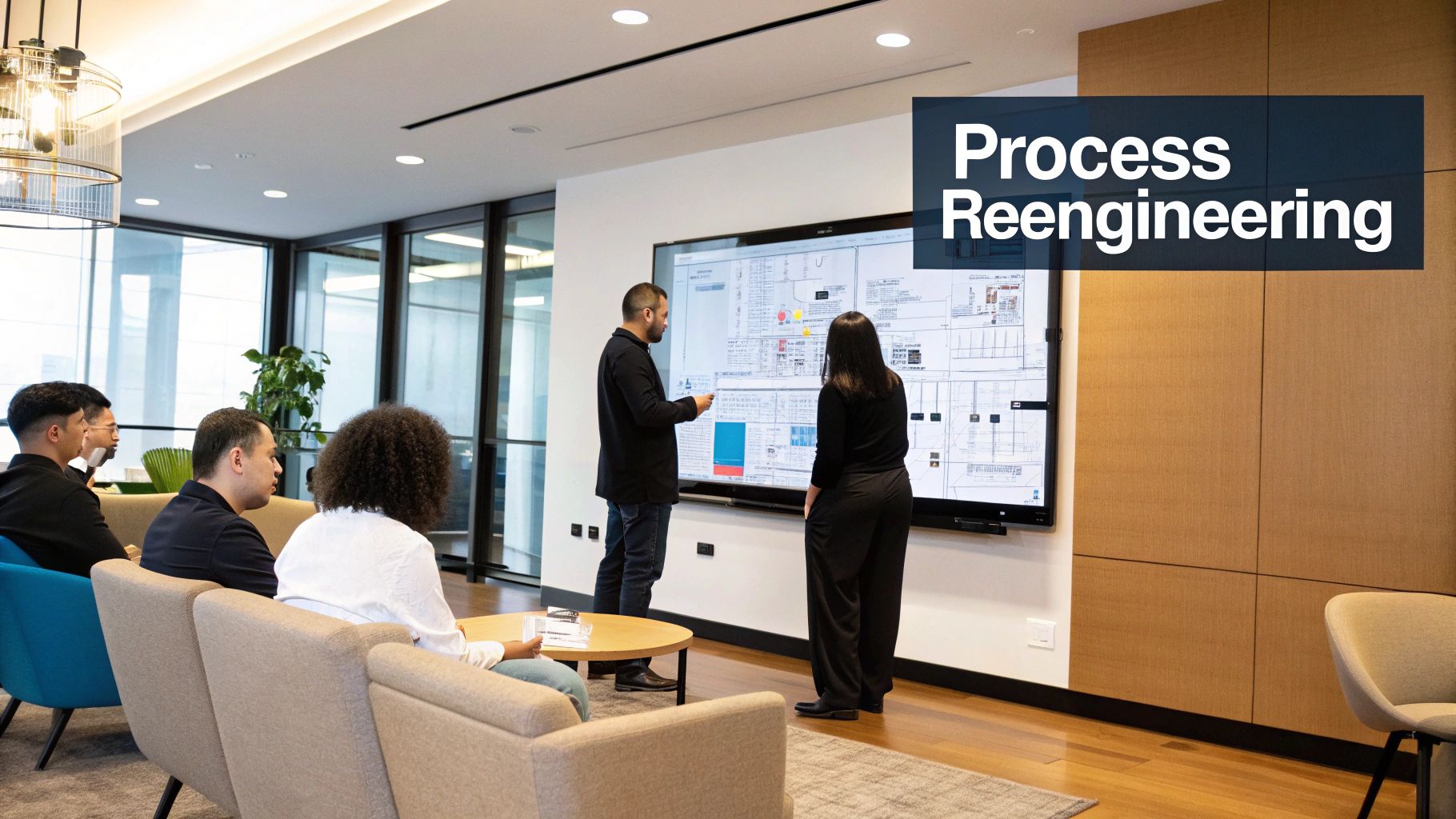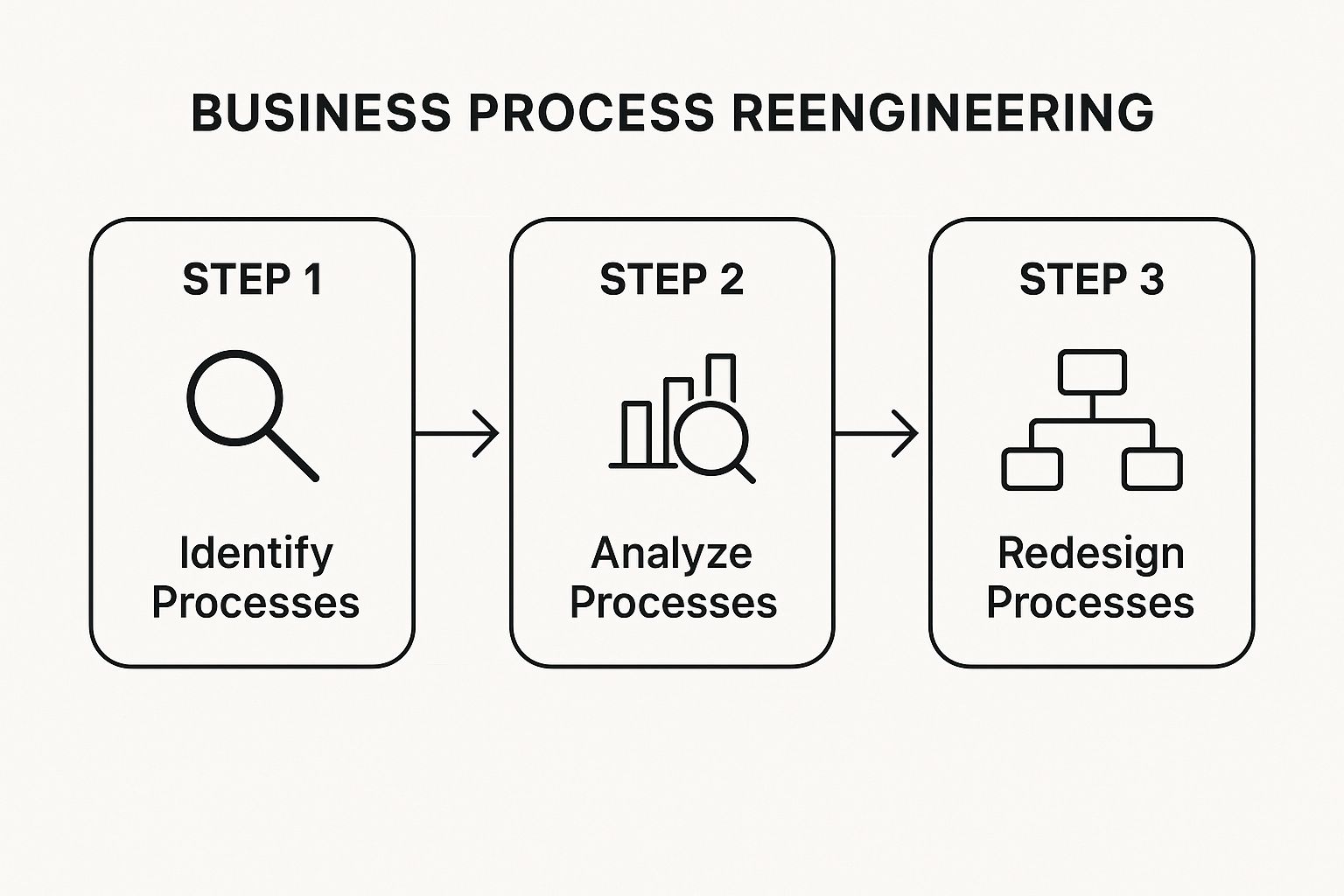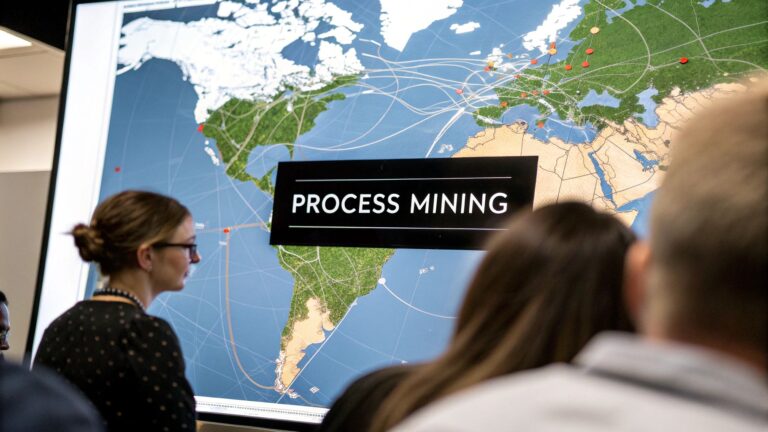What Is Business Process Reengineering A Practical Guide
Business Process Reengineering (BPR) isn't about making small, incremental changes to how you work. It’s a complete, top-to-bottom rethink of your most critical processes to achieve massive leaps in performance. Forget tweaking the system—this is about tearing it down and rebuilding it from scratch to be dramatically faster, better, and more efficient.
What Is Business Process Reengineering Really

Think of it this way: Imagine your company’s order fulfillment process is an old, winding country road. It eventually gets you to your destination, but it's slow and full of potholes. You could patch the holes and trim the weeds along the side—that's continuous improvement.
BPR, on the other hand, is like blasting a tunnel through the mountain and building a brand-new, multi-lane superhighway. It completely bypasses the old road, creating a faster, more direct path.
At its heart, BPR forces you to ask why you do things a certain way. Instead of asking, "How can we do this faster?" you start asking, "Why are we even doing this at all?" This fundamental questioning often reveals that entire steps in a process are outdated or add zero value. Ultimately, BPR is about a radical redesign aimed at achieving staggering improvements by implementing proven strategies to improve workflow efficiency across the entire organization.
The Core Idea Behind BPR
First introduced in the early 1990s, the concept was simple but powerful: fundamentally redesign core business processes to achieve dramatic improvements in productivity, cycle times, and quality. A successful BPR project isn't just about shuffling boxes on an org chart; it's about setting audacious goals, deeply understanding how work currently gets done, and then completely reimagining those workflows, often with technology as the enabler.
The main objectives of any BPR initiative are ambitious by design:
- Drastic Performance Gains: The goal isn't a 10% improvement; it's a 10x improvement. We're talking about slashing cycle times, virtually eliminating errors, and making significant cuts to operational costs.
- Customer-Centric Focus: Processes are redesigned from the customer's perspective, not for internal convenience. You start with what the customer needs and work backward.
- Strategic Alignment: Every redesigned process must directly support the company's bigger goals, whether that's becoming a market leader or achieving unparalleled operational excellence.
BPR starts from the assumption that the current process is fundamentally broken, not just inefficient. It’s a high-risk, high-reward approach for companies seeking breakthrough performance, not just slow and steady gains.
This complete overhaul is what sets BPR apart from other process improvement methods. You aren't just optimizing the old way of doing things; you're inventing a new, better one.
BPR vs. Continuous Improvement
It's easy to confuse BPR with other popular improvement methodologies like Kaizen or Six Sigma, but they are fundamentally different in their philosophy and execution. BPR is a revolutionary act, while continuous improvement is an evolutionary one.
One is about hitting the reset button; the other is about fine-tuning the dial.
BPR vs Continuous Improvement At A Glance
| Aspect | Business Process Reengineering (BPR) | Continuous Improvement (e.g., Kaizen) |
|---|---|---|
| Scope of Change | Radical, revolutionary, and cross-functional. | Incremental, evolutionary, and often focused. |
| Pace of Change | Rapid and disruptive; implemented as a one-time project. | Gradual and ongoing; part of daily operations. |
| Risk & Reward | High risk, high reward. Aims for breakthrough results. | Low risk, moderate reward. Aims for steady gains. |
| Starting Point | A "clean slate" approach; assumes nothing. | The existing process; seeks to refine and improve it. |
| Technology's Role | Often a key enabler for entirely new processes. | Typically used to support or automate existing steps. |
| Cultural Impact | Major cultural shift; often meets with resistance. | Minor adjustments; integrates into the existing culture. |
Choosing between a complete overhaul and incremental improvements depends entirely on your situation. If your processes are just a little inefficient, a continuous improvement approach makes sense. But if they're fundamentally obsolete and holding your business back, it might be time for the BPR superhighway.
The Core Principles Driving BPR Success

Business process reengineering isn't about just shuffling boxes around on an org chart. It's a disciplined approach guided by a few powerful ideas. These core principles are the secret sauce that separates a genuine redesign from just tweaking a broken system.
Think of them as the framework for making the bold moves needed for real, dramatic improvements. Getting a handle on these principles is essential to understanding what is business process reengineering at its heart. They’re the compass that ensures every decision points toward a smarter, faster, and more customer-focused way of working.
Organize Around Outcomes, Not Tasks
This is probably the biggest mental shift in BPR. Traditional business is built like an assembly line, where work is broken down into tiny, specialized tasks and passed from one department to the next. The problem? No one owns the final result.
BPR completely flips that script. It says, "Forget the individual steps; focus on the finished product." Instead of ten people touching a file, one person or a small, empowered team sees the whole process through. This builds a massive sense of ownership and slashes the handoffs where delays and mistakes love to hide.
The classic insurance claims process is a perfect example:
- Task-Based (Before BPR): A claim gets bounced from the mailroom to data entry, to a reviewer, to an adjuster, to a payment processor, and finally to a team that sends out the letter. Every handoff is a potential black hole.
- Outcome-Based (After BPR): One person, a "case manager," owns the claim from the moment it arrives until the check is sent. Their job isn't to process a form; it's to settle the claim.
This simple change gets rid of bottlenecks and puts responsibility squarely on one person's shoulders.
Empower People Closest to the Work
Old-school, top-down management structures are slow and clunky. BPR argues that the people actually doing the work are in the best position to make decisions about it. It’s all about pushing authority down to the front lines.
Rather than making employees wait for three layers of management to approve a simple decision, you give them the training and information they need to solve problems on the spot. This doesn't just speed things up; it boosts morale and makes your company far more responsive. When your team can make real-time calls, processes flow smoothly and customers get what they need faster.
BPR operates on a simple belief: the person doing the job knows the job best. It swaps rigid, bureaucratic control for trust, turning employees from task-doers into true process owners.
Treat Dispersed Resources as Though They Were Centralized
Not long ago, geography was a huge barrier. If you wanted teams to work together, they had to be in the same building. This led to tons of duplication, with multiple departments doing the same job in different cities.
BPR uses technology to make location irrelevant. The idea is to build centralized systems—like shared databases or communication hubs—so that everyone is working from the same playbook, no matter where they are. A salesperson in Chicago and a warehouse manager in Atlanta can look at the exact same real-time inventory data as if they were sitting side-by-side.
This approach gives you the best of both worlds. You get the efficiency of a single, coordinated operation along with the flexibility of having people wherever you need them. It's how modern businesses stay lean, adaptable, and ready to scale.
A Practical Framework for Implementing BPR
Knowing what Business Process Reengineering is and actually pulling off a successful project are two very different things. To get from theory to real-world results without creating total chaos, you absolutely need a structured approach. This framework breaks the BPR journey into clear, manageable stages, giving you a reliable roadmap for what can be a complex but incredibly rewarding initiative.
Think of it like building a new house. You wouldn't just show up and start laying bricks without a detailed blueprint, a solid foundation, and a clear plan. BPR is no different; it demands a methodical game plan to make sure the final result is what you actually set out to build.
Phase 1: Define the Vision and Set Clear Goals
First things first: you need a destination. Before you even think about mapping a process, you have to define what success will look like when you get there. This phase is all about tying the BPR project directly to the company's biggest strategic goals. Are you trying to cut order fulfillment time from two weeks down to just two days? Maybe you're aiming to slash operational costs by 40%?
Whatever the goals are, they have to be specific, measurable, and honestly, a little ambitious. Vague targets like "improve efficiency" just won't cut it. The vision needs to be powerful enough to get the whole company excited about the change, securing that critical support from the top to push through the resistance and resource hurdles that will inevitably pop up. Without a clear "why," any BPR project is dead in the water before it even starts.
Phase 2: Map and Analyze the Current Process
Okay, you know where you're going. Now you need to get a painfully honest look at where you're starting from. This means creating a detailed map of the current process—the "as-is" state. This isn't some high-level flowchart. It means getting into the weeds to document every single step, every handoff, every decision point, and every system involved.
The real purpose here is to pinpoint the root causes of what's broken.
- Bottlenecks: Where does work consistently grind to a halt?
- Redundancies: Which steps are being done over and over for no good reason?
- Non-Value-Adding Activities: What are people doing that adds zero value for the customer?
This analysis gives you the hard data you need to justify a radical redesign. It shifts the conversation from "I think this is slow" to "we can prove this step is the problem," highlighting exactly where the old process fails and why small tweaks won't be enough. To get a better handle on this, you can explore various business process improvement methods that really help flesh out this stage of the analysis.
Phase 3: Design the Future-State Process
This is where the real creativity kicks in. With a solid grasp of the problems, the team can now design the "to-be" process from a completely clean slate. The guiding question is simple: "If we were starting from scratch today, what would be the absolute best way to get this done?"
This infographic helps visualize the core workflow of identifying what's wrong, analyzing why, and then redesigning it.

The image breaks the BPR journey down into three essential steps, showing that the redesign is the final, powerful action that has to be built on a solid foundation of identification and analysis.
In this phase, you should question every old rule and assumption. Technology is often the hero here, opening up brand new ways of working through automation, AI, and integrated software. The final design should be a lean, efficient, and customer-focused workflow that directly solves the pain points you uncovered back in the analysis phase.
Phase 4: Implement and Manage the Change
With the new blueprint in hand, it's time to start building. Implementation needs to be handled with care, often by starting with a pilot program or a phased rollout to keep disruptions to a minimum. This lets the team test the new process in a controlled setting, get feedback, and work out the kinks before launching it across the entire company.
But the technical side is only half the battle. Change management is arguably the most important part of this whole phase.
A technically perfect process will fail if the people who use it don't buy in. Effective communication, comprehensive training, and clear support systems are non-negotiable for ensuring a smooth and successful transition.
Phase 5: Embed Continuous Monitoring
BPR isn't a one-and-done deal. Once the new process is live, you have to constantly monitor how it's performing against the goals you set way back in Phase 1. Key Performance Indicators (KPIs) like cycle time, error rates, and customer satisfaction scores should be tracked obsessively.
This final stage creates a feedback loop, letting the organization make ongoing adjustments and ensuring the new process stays effective as the business changes. This commitment to monitoring is what turns a one-time project into a lasting competitive advantage and builds a true culture of operational excellence.
Real-World Examples of BPR Transformation

The theory behind business process reengineering is great, but nothing drives the point home like seeing it in action. The most powerful lessons come from real companies that took a hard look at their core operations and had the courage to tear them down and build something better.
These stories aren't about small tweaks. They show just how dramatic the results can be when an organization challenges its oldest, most ingrained assumptions. We’re talking about massive cost savings, lightning-fast cycle times, and a genuine competitive advantage.
The Classic Ford Accounts Payable Overhaul
If you've ever studied BPR, you've probably heard about Ford. It's the textbook case for a reason. Back in the 1990s, Ford's accounts payable department was a beast, with over 500 people on staff. Their process was a classic example of bureaucratic bloat.
Here’s how it worked (or didn't):
- Purchasing sent a purchase order to a vendor.
- The receiving dock got the goods and sent a receiving slip to accounts payable.
- The vendor sent an invoice to accounts payable.
- A clerk’s entire job was to manually match those three pieces of paper. If everything lined up, a check was cut.
As you can imagine, this matching game was a nightmare. Most of the clerks' time wasn't spent paying bills; it was spent hunting down discrepancies and fixing errors. It was slow, expensive, and frustrating.
Ford’s initial goal was timid: a 20% reduction in headcount. But then they looked at Mazda (a company they partly owned) and saw its tiny accounts payable team. This was the lightbulb moment. Ford stopped asking, "How can we do this faster?" and started asking, "Why are we doing this at all?"
They challenged the fundamental assumption that "we pay when we get an invoice." Instead, Ford decided to pay when they received the goods. Simple, right? But it changed everything.
The new process was almost elegant in its simplicity. When a shipment arrived, a dock worker checked a database. If the goods matched an open purchase order, they accepted the delivery, and the system automatically scheduled the payment. No match? The shipment went back. No more invoices.
The result? A staggering 75% reduction in staff. Payments became faster and more accurate. This single project became a legendary BPR success story, showing how rethinking a process from the ground up can yield incredible results.
A Modern Fintech Loan Approval Redesign
BPR isn't just a relic of the 90s; its principles are more powerful than ever with today's technology. Take a modern fintech company, for example, stuck with a painfully slow, manual loan approval process. It took weeks to give customers an answer, and they were losing business to faster competitors every day.
The old process was a mess of handoffs between loan officers, underwriters, and compliance teams, all shuffling paper documents. To fix this, the company didn't just digitize the old steps—it completely reimagined the customer's journey from start to finish.
The new workflow looked completely different:
- Customers now use a digital portal to upload all their documents in one go.
- AI algorithms handle the initial credit checks and risk assessments in seconds, not days.
- An automated system routes the application to a human specialist only when it's absolutely necessary.
This is a prime example of what happens when you learn how to automate business processes with a clean-slate mentality. By focusing on the desired outcome—a fast, accurate decision—the company turned a weeks-long ordeal into a process that can take just a few minutes.
The impact was huge. Customer satisfaction skyrocketed, and the company could handle a much higher volume of loans with the same team, directly boosting its bottom line.
The Role of Technology in Modern BPR
In the early days, Business Process Reengineering was all about big ideas, whiteboards, and flowcharts. Today, technology is at the heart of the conversation. Modern BPR isn't just about rethinking a workflow; it's about rebuilding it from the ground up with digital tools that unlock efficiencies we could only dream of a decade ago.
Technology is the engine that powers this radical redesign. It doesn’t just speed up old tasks—it creates entirely new ways of working. Think of it this way: you can give a horse a lighter saddle to make it a bit faster, or you can invent the automobile. One is a simple tweak; the other is a fundamental game-changer.
This potential has caught the attention of businesses everywhere. The global Business Process Reengineering market is experiencing massive growth, spurred on by breakthroughs in AI, automation, and advanced analytics tools. Industries from banking and retail to manufacturing are all jumping on board, looking for that next competitive edge. You can read more about the growth of the BPR market on HTF Market Insights.
Automation: The New Workforce
At the forefront of tech-driven BPR is Robotic Process Automation (RPA). RPA deploys software "bots" that perfectly mimic repetitive human actions. Imagine a digital employee who can copy-paste data, fill out forms, or move files 24/7 without a single error or coffee break.
For instance, instead of a team spending hours manually processing invoices, a single RPA bot can clear the queue in minutes. This isn't just about cutting costs. It frees up your human talent to tackle more complex, high-value work like strategic analysis and building customer relationships.
Intelligent Process Redesign With AI
If RPA handles the "doing," artificial intelligence and machine learning handle the "thinking." AI adds a layer of intelligence that takes BPR to a whole new level. It can dig through massive datasets to spot hidden patterns, predict future outcomes, and make smart decisions on the fly.
This opens the door to truly innovative process designs:
- Predictive Customer Service: AI can analyze behavior to identify at-risk customers and trigger proactive outreach before they ever think of leaving. This flips the entire customer service model from reactive to proactive.
- Dynamic Supply Chains: AI algorithms can adjust logistics in real-time based on weather, traffic, and shifting demand, creating a supply chain that's not just efficient but also incredibly resilient.
- Intelligent Document Processing: AI can read, understand, and extract data from unstructured documents like emails and PDFs, automating complex approvals that used to require a human's judgment.
Gaining Visibility With Process Mining
You can't fix what you can't see. This is where process mining comes in—it’s like an X-ray for your company's operations. This software analyzes the digital footprints left behind in your IT systems (like your CRM or ERP) to create a visual map of how work actually gets done, not just how you think it gets done.
Process mining uncovers the hidden bottlenecks, sneaky deviations, and costly inefficiencies that are often invisible during day-to-day work. Our guide offers a much deeper look into what is process mining and how it lays a data-driven foundation for any BPR project. In a similar vein, many modern BPR efforts also use specialized customer feedback collection tools to get a clearer picture of external-facing processes.
Technology in BPR is not just an add-on; it is the enabler. It provides the tools to not only design a better process but to build one that is intelligent, automated, and capable of adapting to future challenges.
Common BPR Pitfalls and How to Avoid Them
Jumping into a business process reengineering initiative is a big deal. The potential rewards are huge, but the path is littered with traps that can easily sink the entire project. In fact, some studies show that a staggering 70% of BPR projects don't hit their targets.
Knowing where others have gone wrong is your best defense. If you can anticipate these challenges, you can build a strategy that's not just ambitious but also realistic and tough enough to see you through.
Forgetting the Human Element
Probably the biggest mistake companies make is treating BPR like it’s just a puzzle of flowcharts and software. They architect a process that looks perfect on paper but completely ignores the people who have to execute it every single day. Big changes like these naturally stir up fear and resistance—employees worry about their jobs or just feel completely overwhelmed by new ways of working.
When that happens, even the most brilliantly designed process is dead on arrival.
- How to Avoid It: You have to bake change management into your BPR strategy from day one, not tack it on at the end. Be radically transparent about why the changes are necessary. Better yet, get employees involved in the redesign. Their on-the-ground knowledge is pure gold, and having a hand in building the new process creates a powerful sense of ownership. Finally, invest seriously in training and support to prove you’re backing your team through the transition.
Lack of Genuine Executive Sponsorship
A BPR project without a truly committed executive sponsor is like a ship without a rudder. It needs a leader who does more than just approve the budget. This person needs to be in the trenches, actively clearing roadblocks, fighting for resources, and constantly championing the vision across the company.
A simple nod of approval from the corner office just won't cut it. Your project needs a champion who will go to bat for it when the going gets tough.
A common pitfall is mistaking executive interest for genuine sponsorship. A true sponsor spends their political capital to shield the project, make the hard calls, and keep everyone focused on the prize, especially after the initial excitement wears off.
Focusing Only on Cost Cutting
Sure, saving money is often a happy outcome of BPR, but it should never be the only goal. When you fixate only on slashing expenses, you end up making shortsighted decisions that can wreck quality, frustrate customers, and crush employee morale. Real reengineering is about creating more value, not just spending less money.
Think of it this way: redesigning a process to get a product to a customer in half the time is about creating a better, faster, more valuable experience. The cost savings are a great bonus, not the whole point.
- How to Avoid It: Frame your BPR goals around creating value.
- Boost customer satisfaction by reimagining your support process from the ground up.
- Slash time-to-market by overhauling how you develop new products.
- Elevate product quality by redesigning your entire quality assurance workflow.
When you aim for these kinds of positive outcomes, the cost savings tend to follow naturally. This approach also makes it a whole lot easier to get your team excited and on board with the new direction.
Frequently Asked Questions About BPR
Many business leaders wonder if business process reengineering is simply a polite way to announce layoffs. That misconception dates back to early efforts where cutting roles was the first fix. In reality, BPR zeroes in on streamlining workflows to boost value rather than trimming headcount.
For instance, one manufacturer slashed cycle time by 75% without letting anyone go. They automated tedious, manual tasks and redirected staff to higher-value activities. The result? Better efficiency, higher quality and happier customers.
- BPR Redefines Workflows: Targets entire processes end to end, not just individual jobs
- Value Creation Focus: Measures success by speed, cost savings and customer impact
- Technology As An Enabler: Introduces new capabilities—not merely automating old tasks
| Myth | Reality |
|---|---|
| BPR Is Code For Layoffs | Focuses On Process Value |
| It Only Reduces Staff | Drives Efficiency And Quality |
Starting With The Right Foundation
“What’s the first move in a BPR project?” you might ask. The answer is simple: establish a clear strategic vision. Link your redesign efforts directly to overarching business objectives to keep everyone pulling in the same direction.
- Define Clear Goals: Pinpoint the improvements you want—faster cycle times, fewer errors, etc.
- Secure Leadership Support: Rally executives to champion the work and allocate resources.
- Communicate Purpose: Explain the “why” and “how” to every team member for buy-in.
A solid strategic foundation acts as your compass throughout any major redesign.
Nailing this phase keeps your project from veering off course or stalling under resistance.
Scaling BPR For Small Businesses
Small companies often assume BPR demands deep pockets. In truth, even a lean team can overhaul a critical process and reap big wins. Take a boutique agency that mapped its client onboarding, stripped out redundant approvals and cut onboarding time by 50%—all with free or low-cost tools.
- Identify One High-Impact Process: Zero in on the area with the fastest payback.
- Use Simple Tools: Leverage no-cost mapping software and cloud collaboration.
- Pilot Rapidly: Test changes on a small scale, measure the outcome, then scale what works.
You don’t need a Fortune 500 budget to benefit from BPR. Its principles adapt to any organization.
Similarly, a regional café chain reengineered its order fulfillment by removing extra steps and unifying orders on one dashboard. Order accuracy climbed and wait times fell.
- Outcome Metrics: Track wait-time reductions and accuracy improvements
- Team Engagement: Gauge staff satisfaction post-implementation
- Customer Feedback: Collect quick survey responses to monitor service quality
Partner with MakeAutomation today to streamline your operations: MakeAutomation
Get started now and watch improvements roll in.
See measurable results faster than you might expect.







